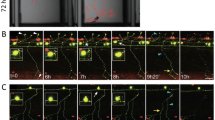Abstract
Although the zebrafish (Danio rerio) has been used extensively for many years in neurodevelopmental studies, use of this teleost to study neurological diseases has evolved only recently. Being a vertebrate, this animal offers advantages for the study of human disease over other small animals, such as the fly or worm. Genetic, as well as nongenetic, disorders can be modeled in both the adult organism and the embryo. Genetic manipulation of the embryo to generate stable and transiently expressing transgenic fish, and to knockdown genes to study loss of their function, can be easily achieved. Because of large offspring numbers screening studies can also be readily performed. Here, we describe some of the protocols useful for modeling neurodegenerative disease in zebrafish embryos, with particular emphasis on models to study motor neuron phenotypes.
Access this chapter
Tax calculation will be finalised at checkout
Purchases are for personal use only
Similar content being viewed by others
References
Bill, B. R., Petzold, A. M., Clark, K. J., Schimmenti, L. A., and Ekker, S. C. (2009) A primer for morpholino use in zebrafish. Zebrafish. 6, 69–77.
Schiffer, N. W., Broadley, S. A., Hirschberger, T., Tavan, P., Kretzschmar, H. A., Giese, A., Haass, C., Hartl, F. U., and Schmid, B. (2007) Identification of anti-prion compounds as efficient inhibitors of polyglutamine protein aggregation in a zebrafish model. J Biol Chem. 282, 9195–9203.
Paquet, D., Bhat, R., Sydow, A., Mandelkow, E. M., Berg, S., Hellberg, S., Falting, J., Distel, M., Koster, R. W., Schmid, B., and Haass, C. (2009) A zebrafish model of tauopathy allows in vivo imaging of neuronal cell death and drug evaluation. J Clin Invest. 119, 1382–1395.
van Bebber, F., Paquet, D., Hruscha, A., Schmid, B., and Haass, C. Methylene blue fails to inhibit Tau and polyglutamine protein-dependent toxicity in zebrafish. Neurobiol Dis.
Saint-Amant, L., and Drapeau, P. (2003) Whole-cell patch-clamp recordings from identified spinal neurons in the zebrafish embryo. Methods Cell Sci. 25, 59–64.
Creton, R. (2009) Automated analysis of behavior in zebrafish larvae. Behav Brain Res. 203, 127–136.
Blaser, R., and Gerlai, R. (2006) Behavioral phenotyping in zebrafish: comparison of three behavioral quantification methods. Behav Res Methods. 38, 456–469.
McWhorter, M. L., Monani, U. R., Burghes, A. H., and Beattie, C. E. (2003) Knockdown of the survival motor neuron (Smn) protein in zebrafish causes defects in motor axon outgrowth and pathfinding. J Cell Biol. 162, 919–931.
Lemmens, R., Van Hoecke, A., Hersmus, N., Geelen, V., D’Hollander, I., Thijs, V., Van Den Bosch, L., Carmeliet, P., and Robberecht, W. (2007) Overexpression of mutant superoxide dismutase 1 causes a motor axonopathy in the zebrafish. Hum Mol Genet. 16, 2359–2365.
Kabashi, E., Lin, L., Tradewell, M. L., Dion, P. A., Bercier, V., Bourgouin, P., Rochefort, D., Bel Hadj, S., Durham, H. D., Vande Velde, C., Rouleau, G. A., and Drapeau, P. Gain and loss of function of ALS-related mutations of TARDBP (TDP-43) cause motor deficits in vivo. Hum Mol Genet. 19, 671–683.
Ramesh, T., Lyon, A. N., Pineda, R. H., Wang, C., Janssen, P. M., Canan, B. D., Burghes, A. H., and Beattie, C. E. A genetic model of amyotrophic lateral sclerosis in zebrafish displays phenotypic hallmarks of motoneuron disease. Dis Model Mech.
Flinn, L., Mortiboys, H., Volkmann, K., Koster, R. W., Ingham, P. W., and Bandmann, O. (2009) Complex I deficiency and dopaminergic neuronal cell loss in parkin-deficient zebrafish (Danio rerio). Brain. 132, 1613–1623.
Bai, Q., Garver, J. A., Hukriede, N. A., and Burton, E. A. (2007) Generation of a transgenic zebrafish model of Tauopathy using a novel promoter element derived from the zebrafish eno2 gene. Nucleic Acids Res. 35, 6501–6516.
Hallare, A., Nagel, K., Kohler, H. R., and Triebskorn, R. (2006) Comparative embryotoxicity and proteotoxicity of three carrier solvents to zebrafish (Danio rerio) embryos. Ecotoxicol Environ Saf. 63, 378–388.
Parng, C., Ton, C., Lin, Y. X., Roy, N. M., and McGrath, P. (2006) A zebrafish assay for identifying neuroprotectants in vivo. Neurotoxicol Teratol. 28, 509–516.
Acknowledgments
This work was supported by grants from the K.U.Leuven. WR is supported through the E von Behring Chair for Neuromuscular and Neurodegenerative Disorders and by the IUAP program P6/43 of the Belgian Federal Science Policy Office.
Author information
Authors and Affiliations
Corresponding author
Editor information
Editors and Affiliations
Rights and permissions
Copyright information
© 2011 Springer Science+Business Media, LLC
About this protocol
Cite this protocol
Laird, A.S., Robberecht, W. (2011). Modeling Neurodegenerative Diseases in Zebrafish Embryos. In: Manfredi, G., Kawamata, H. (eds) Neurodegeneration. Methods in Molecular Biology, vol 793. Humana Press, Totowa, NJ. https://doi.org/10.1007/978-1-61779-328-8_11
Download citation
DOI: https://doi.org/10.1007/978-1-61779-328-8_11
Published:
Publisher Name: Humana Press, Totowa, NJ
Print ISBN: 978-1-61779-327-1
Online ISBN: 978-1-61779-328-8
eBook Packages: Springer Protocols




